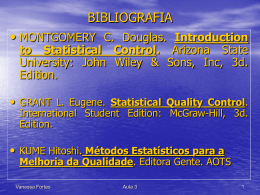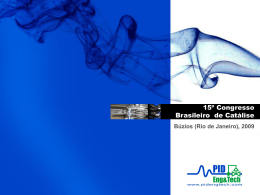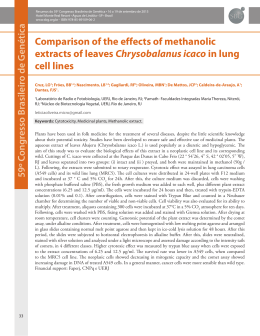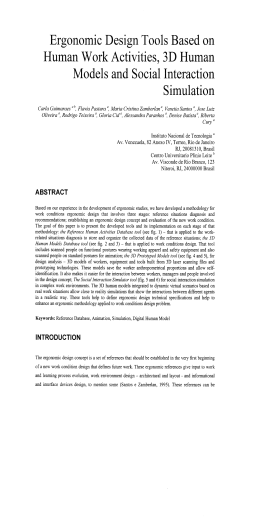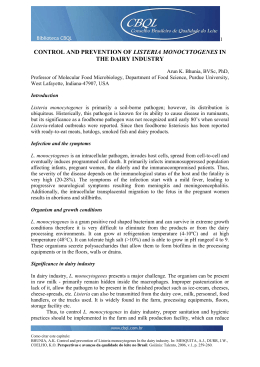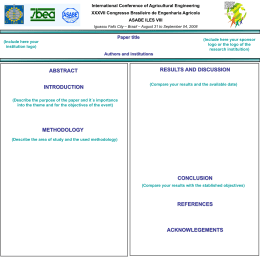Como citar este capítulo: CORRIGAN, B. Canadian dairy lab network and analysis process presented for III Congresso Brasileiro de Qualidade do Leite. In: BARBOSA, S.B.P., BATISTA, A.M.V., MONARDES, H. III Congresso Brasileiro de Qualidade do Leite. Recife: CCS Gráfica e Editora, 2008, v.1, p. 265-278. Canadian Dairy Lab Network and Analysis Process Presented for III Congresso Brasileiro De Qualidade Do Leite Presented by Brian Corrigan, Laboratory Manager, Valacta Montreal, Quebec, Canada Agenda The following presentation provides an overview of the Canadian Dairy Industry; dairy laboratories in Canada ; milk sample collection and analysis process followed for herd management and payment purposes ; internal ,external quality control and (accreditation) procedures/requirements that are followed by the dairy laboratories . Valacta and Canadian Dairy Herd Improvement : An important part of the Dairy Network is Canadian Dairy Herd Improvement. (CDHI) CDHI is composed of 2 Canadian agencies Valacta, and Canwest, working in partnership to assist dairy producers across Canada. Both organizations provide herd management services for their clients , where Valacta serves eastern Canada and Canwest serves Western Canada. Valacta Valacta employees over 300 employees serving 6000 clients in eastern Canada. Services include • • • • • • Laboratory analyses Data entry and processing Milk recording Advisory on farm services Research, Development, Expertise Circulation of knowledge The Valacta head office located on the island of Montreal, in Quebec has 68 employees. The head office provides • Laboratory analysis for dairy DHI individual cow, bulk tank-payment, feed, and reference. • Information Technologies ,processing data for all Canada • Customer service and distribution • Research and Development • Administration, human resources, communications The laboratory provides analysis for 225,000 samples a month for DHI and analyzes close to 100% of samples the same day received in the lab, operating 6 days per week. Samples are all barcoded and received within 24 hours of collection at the farm, analyzed for fat protein and somatic cell count. Over 40% of the samples are also analyzed for urea, an optional service provided to clients. The Valacta laboratory also provides fat, protein, lactose and total solids analysis for bulk tank and truck samples for determination of milk value for payment purposes. Bulk tank samples are also analyzed for quality purposes and to assist with the management of mastitis . Disponível em: http://www.cbql.com.br/biblioteca.php Como citar este capítulo: CORRIGAN, B. Canadian dairy lab network and analysis process presented for III Congresso Brasileiro de Qualidade do Leite. In: BARBOSA, S.B.P., BATISTA, A.M.V., MONARDES, H. III Congresso Brasileiro de Qualidade do Leite. Recife: CCS Gráfica e Editora, 2008, v.1, p. 265-278. Valacta laboratory also provides an optional forage analysis service to clients. The Valacta reference laboratory is a critical segment not only for the Valacta laboratory but for the dairy industry, providing calibration samples for many labs and plants in Canada, Brazil, Mexico, and Columbia. The reference laboratory is required to follow all IDF (International Dairy Federation ) procedures. Fat analysis by Mojonnier, Protein analysis by Kjeldahl, Lactose by HPLC. Canadian Dairy Industry In Canada the dairy industry covers over 5000 kms from the east coast to the west coast.. As of January 2008 : 988,500 dairy cows; 14,660 dairy farms; 12 dairy laboratories The following chart provides a summary of how many farms are in Canada and the trend of herd growth over the past few years. From 1990 to 2007 the number of herds has decreased from 35,000 to 14,660. Disponível em: http://www.cbql.com.br/biblioteca.php Como citar este capítulo: CORRIGAN, B. Canadian dairy lab network and analysis process presented for III Congresso Brasileiro de Qualidade do Leite. In: BARBOSA, S.B.P., BATISTA, A.M.V., MONARDES, H. III Congresso Brasileiro de Qualidade do Leite. Recife: CCS Gráfica e Editora, 2008, v.1, p. 265-278. The following chart provides the cow growth trends across Canada. As is the trend in many countries, though the number of herds is decreasing, the number of cows per herd is increasing therefore the total reduction in cows is not as significant There has been a decrease since 1990 from 1.4 million to just under 1 million cows in Canada. Disponível em: http://www.cbql.com.br/biblioteca.php Como citar este capítulo: CORRIGAN, B. Canadian dairy lab network and analysis process presented for III Congresso Brasileiro de Qualidade do Leite. In: BARBOSA, S.B.P., BATISTA, A.M.V., MONARDES, H. III Congresso Brasileiro de Qualidade do Leite. Recife: CCS Gráfica e Editora, 2008, v.1, p. 265-278. The Canadian Dairy Laboratory Network consist of the following services: • • • • • Herd Management (DHI) Analysis Payment Analysis (for all herds) - Bulk Tank and truck samples (F,P,L, TS) Quality Testing - Somatic Cell Count, Bacteria, Antibiotics Canadian Laboratory Services (CLS) - Interlab exchanges, Standards Council of Canada:- Audits, ISO 17025 accreditation There are 12 dairy testing laboratories across Canada that provide a variety of the services described. Some laboratories provide all the services while others provide only one . 6 of the Dairy Laboratories provide DHI individual cow testing as well as other services. 2 of these laboratories are testing for Valacta clients in Eastern Canada 4 of the laboratories are testing for Canwest in Western Canada. These laboratories are equipped with 15 infra red and somatic cell count analyzers, including Bentley 2000’s IR, 300’s 500’s for somatic cell count, Foss 4000’s, 6000’s, 400’s and FC’s Disponível em: http://www.cbql.com.br/biblioteca.php Como citar este capítulo: CORRIGAN, B. Canadian dairy lab network and analysis process presented for III Congresso Brasileiro de Qualidade do Leite. In: BARBOSA, S.B.P., BATISTA, A.M.V., MONARDES, H. III Congresso Brasileiro de Qualidade do Leite. Recife: CCS Gráfica e Editora, 2008, v.1, p. 265-278. Disponível em: http://www.cbql.com.br/biblioteca.php Como citar este capítulo: CORRIGAN, B. Canadian dairy lab network and analysis process presented for III Congresso Brasileiro de Qualidade do Leite. In: BARBOSA, S.B.P., BATISTA, A.M.V., MONARDES, H. III Congresso Brasileiro de Qualidade do Leite. Recife: CCS Gráfica e Editora, 2008, v.1, p. 265-278. % Growth in herds testing on DHI The total number of samples tested for DHI in 2007 was just under 6,000,000. where the majority were analyzed in Central Canada: Quebec (2,765,716) , Ontario 1,837,183. Milk sample collection procedures for DHI testing . • • • • Field technicians or producers collect milk and herd data All samples are bar-coded Samples are preserved with Bronopol Transport: Most samples are shipped by courier and delivered within 24-hour Types of analysis provided throughout the DHI laboratories: • All samples are analysed for Fat, Protein and Cell Count • Urea and lactose analysis is offered in several labs • Same day analysis is provided across Canada. • CanWest offers Johne’s and leukosis testing • Forage analysis is provided at the Valacta lab. • Analysis results are transferred to Canadian DHI processing centre at Valacta head office and made available to clients via web site, or hard copy. Disponível em: http://www.cbql.com.br/biblioteca.php Como citar este capítulo: CORRIGAN, B. Canadian dairy lab network and analysis process presented for III Congresso Brasileiro de Qualidade do Leite. In: BARBOSA, S.B.P., BATISTA, A.M.V., MONARDES, H. III Congresso Brasileiro de Qualidade do Leite. Recife: CCS Gráfica e Editora, 2008, v.1, p. 265-278. Fresh Milk Bulk Tank and truck sample testing for payment. The payment analysis system follows regulated procedures for sample collection. A bulk tank sample is collected at every load pick up (every 2 days) and a truck sample is taken when delivered to the plant. All samples are sent to the laboratory. All truck samples are analyzed , and one sample per week is analyzed from each producer bulk tank. (4 per month). The average of the 4 results are used to determine the payment. For the payment system to function efficiently , all involved (drivers, plants, laboratories, must follow proper procedures). Driver’s are required to take : • One sample taken from each BT • Tamper-evident plastic vials must be used. • No milk preservative • Samples must be kept refrigerated 1 to 4 Celsius • All samples are bar-coded Dairy Plant requirements : • Samples must be delivered by drivers to the plant where samples are required to be stored at 4 degrees. • Samples are placed in support racks identified with barcodes in the plant refrigerator for shipment to the laboratory. • Provide refrigerated space for all producer bulk tank samples. • Collect one milk sample from each truck load / delivery to be used to determine value of load. ---------------------Laboratory Responsibilities: • • • • • • • • At least twice a week, producer and truck samples are collected in refrigerated trucks and sent to the lab. For some distant plants, samples are shipped in ice packed coolers. All samples stored at 4 Celsius, with proof of temperature. Lab selects one producer sample per week (4x /month) for analysis Analysis for fat, protein, lactose, total solids Results are transmitted to the FPLQ (Federation of Quebec Dairy Producers) and to the dairy plants The laboratory calibrates infra red equipment at least twice per month and follows all IDF (International Dairy Federation ) quality control procedures. Follow all ISO 17025 procedures, and participates in the Canadian Lab Accreditation program. Quality Analysis • • • Quality analysis provided includes: • Bacteria analysis (Petri method, Foss Bactoscan, Bently IBC Bactocount) • Antibiotic testing (Snap Idexx at the plant , Delvo lab test) • Somatic Cell Count analysis (Foss, Bentley) One bulk tank sample is taken at least once per month for quality testing . If bulk tank antibiotic tests are found positive at plant receiving, milk is rejected. The quality analysis service is provided by 6 of the 12 labs mentioned. Disponível em: http://www.cbql.com.br/biblioteca.php Como citar este capítulo: CORRIGAN, B. Canadian dairy lab network and analysis process presented for III Congresso Brasileiro de Qualidade do Leite. In: BARBOSA, S.B.P., BATISTA, A.M.V., MONARDES, H. III Congresso Brasileiro de Qualidade do Leite. Recife: CCS Gráfica e Editora, 2008, v.1, p. 265-278. Q.C. - Valacta laboratory: With an average of 15,000 cow samples analyzed per day for herd management, and 10,000 bulk tank and truck samples per week it is essential that all quality control procedures are followed, monitoring the output from all instruments, to identify and resolve analyzer problems. Internal QC procedures Daily:-Start up: 15/20 minutes: Weekly: -water bath 40 C. -pilot sample : .03 payment, .05 DHI -repeatability .03 payment, .05 DHI -3 ranges of somatic cell count. +/- 10% -validation by chemistry of infra red for payment once per week. -Pilot/control sample - all components. -Calibration verification and adjustments from calibration kits prepared in Valacta reference lab, 12 ranges of fat, protein, lactose. -Homogenization verification. -Purging efficiency checks. -Inter analyzer comparison (18 samples , mean .03, st.dev. .02). Reference calibration service requirements: • • • • Calibration kits are provided for wide variety of dairy labs and plants every 2 weeks Calibration kits must have a variety of milk from various breeds and for compositional variation. Milk collected from various bulk tanks and silos from different plants to assist in creating necessary variety of milk. The reference lab must be accredited and participate in: – the Canadian Lab Accreditation Program, – the International Sample Exchange Program. External Quality Assurance Program • • • • All Canadian DHI and payment laboratories must participate in the Canadian Laboratory Accreditation Program (CLAP) and also meet ISO 17025 requirements. The CLAP was created to provide harmonization in testing amongst the laboratories across Canada. Accreditation is delivered by the Standards Council of Canada and coordinated by Canadian Laboratory Services .CLS is primarily funded by the Dairy producers and plants of Canada. Standards Council of Canada will audit all laboratories every two years to assure that the laboratories are following proper IDF documented procedures as well as participating in the appropriate proficiency testing programs (sample exchange). Disponível em: http://www.cbql.com.br/biblioteca.php Como citar este capítulo: CORRIGAN, B. Canadian dairy lab network and analysis process presented for III Congresso Brasileiro de Qualidade do Leite. In: BARBOSA, S.B.P., BATISTA, A.M.V., MONARDES, H. III Congresso Brasileiro de Qualidade do Leite. Recife: CCS Gráfica e Editora, 2008, v.1, p. 265-278. PROFICIENCY TESTING PROGRAM 1. Canadian Laboratory Services (CLS) is responsible to prepare and distribute samples to all laboratories (overnight shipping) to assess analytical performance of each laboratory and instrument. 2. 20 blind duplicate samples are sent to all laboratories (reference and infra red) 6 times per year on a prearranged schedule. 3. 16 individual samples are sent to all labs on an un announced schedule. 4. Laboratories are responsible to analyze samples within 48 hrs and transfer results to CLS electronically. CLS returns results to the laboratories electronically in less than 3 days. 5. Infrared analysis is compared to the reference laboratory averages. 6. Data analysis and reporting of results is coordinated by CLS. 7. All proficiency testing includes fat, protein, somatic cell count, and urea. The 6 trials include lactose and other solids. Tolerances accepted: 1- Fat and Protein: -MD<+/-0.04, SDD >04% in 3 of last 4 trials with RMD (rolling mean difference) <0.02% for last 6 trials. 2- Somatic Cell Count: -M%D< 10% SD%D<10% RMD (rolling mean difference) <5% over last 6 trials. Disponível em: http://www.cbql.com.br/biblioteca.php Como citar este capítulo: CORRIGAN, B. Canadian dairy lab network and analysis process presented for III Congresso Brasileiro de Qualidade do Leite. In: BARBOSA, S.B.P., BATISTA, A.M.V., MONARDES, H. III Congresso Brasileiro de Qualidade do Leite. Recife: CCS Gráfica e Editora, 2008, v.1, p. 265-278. FAT infra red vs reference Urea vs reference Somatic cell count Disponível em: http://www.cbql.com.br/biblioteca.php Como citar este capítulo: CORRIGAN, B. Canadian dairy lab network and analysis process presented for III Congresso Brasileiro de Qualidade do Leite. In: BARBOSA, S.B.P., BATISTA, A.M.V., MONARDES, H. III Congresso Brasileiro de Qualidade do Leite. Recife: CCS Gráfica e Editora, 2008, v.1, p. 265-278. The Canadian Lab Accreditation Program • • • All Canadian dairy laboratories are ISO 17025 accredited. The Canadian Lab Services (CLS) and the Standards Council of Canada are responsible for auditing of all Valacta, CanWest and payment and quality analysis laboratories. The CLS is also responsible to coordinate and oversee unknown interlab exchange program. Samples are distributed and analysed 6 times per year and results from all laboratories are compared to the reference. Auditing Process: • • Audits conducted by Standards Council of Canada every two years. Auditor’s verify: – Staff training – Lab documentation – Record keeping – Equipment maintenance – Sample handling and preparation – Temperature monitoring and control – Lab supplies, reagents – Analytical performance Auditing includes basic lab quality control: • • • • • • Pre Calibration checks Repeatablity checks Instrument stability- zero drift Pilot sample results Hourly controls Interlaboratory sample analysis participation meeting all requirements. Failure to pass audit and inter laboratory proficiency testing requirements can lead to loss of accreditation. Conclusion The primary objective of the laboratory quality control procedures, and the Canadian Lab Accreditation Program is to ensure that results are uniform across Canada, and milk analysis is provided in the best most efficient and effective way. With the cooperation of laboratories, the support of Standards Council of Canada, Canadian Laboratory Services, and the dairy industry , this objective has been met, and dairy clients have confidence in the analysis system . Disponível em: http://www.cbql.com.br/biblioteca.php Como citar este capítulo: CORRIGAN, B. Canadian dairy lab network and analysis process presented for III Congresso Brasileiro de Qualidade do Leite. In: BARBOSA, S.B.P., BATISTA, A.M.V., MONARDES, H. III Congresso Brasileiro de Qualidade do Leite. Recife: CCS Gráfica e Editora, 2008, v.1, p. 265-278. Disponível em: http://www.cbql.com.br/biblioteca.php
Download

